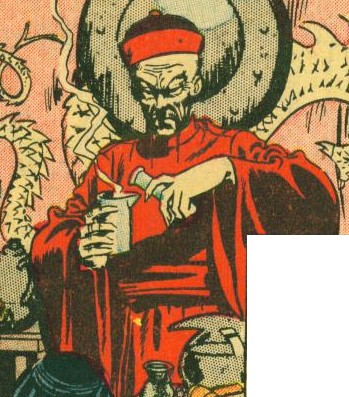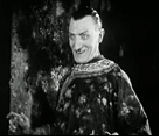 Real
Name: Fu Manchu
Real
Name: Fu Manchu
Identity/Class: Normal human employing chemical means to extend his lifespan
Occupation: Leader of the Si-Fan cult
Affiliations: The Si-Fan, Fah Lo Suee
Enemies: Sir Denis Nayland Smith, Dr.Petrie, Scotland Yard
Known Relatives: Fah Lo Suee (daughter)
Aliases: The Devil Doctor, the Celestial One
Base of Operations: China; when based in Britain, he generally uses the Limehouse district of London
First Appearance: "The Zayat Kiss" (The Story-Teller, October 1912)
Powers/Abilities: Fu Manchu is a master of both ancient mystical abilities and modern scientific advances. Utilizing a magic drug called the Elixir Vitae, Fu Manchu has retained youth and strength despite his advanced age. He can hypnotize (almost) anyone he looks in the eyes.
 History:
Sax Rohmer's Devil Doctor. "Imagine a person, tall, lean and feline,
high-shouldered, with a brow like Shakespeare and a face like Satan, a
close-shaven skull, and long, magnetic eyes of the true cat-green. Invest
him with all the cruel cunning of an entire Eastern race, accumulated in
one giant intellect, with all the resources of science past and present,
with all the resources, if you will, of a wealthy government--which, however,
already has denied all knowledge of his existence. Imagine that awful being,
and you have a mental picture of Dr. Fu-Manchu, the yellow peril incarnate
in one man."
History:
Sax Rohmer's Devil Doctor. "Imagine a person, tall, lean and feline,
high-shouldered, with a brow like Shakespeare and a face like Satan, a
close-shaven skull, and long, magnetic eyes of the true cat-green. Invest
him with all the cruel cunning of an entire Eastern race, accumulated in
one giant intellect, with all the resources of science past and present,
with all the resources, if you will, of a wealthy government--which, however,
already has denied all knowledge of his existence. Imagine that awful being,
and you have a mental picture of Dr. Fu-Manchu, the yellow peril incarnate
in one man."
-- Nayland Smith to Dr. Petrie, The Insidious Dr. Fu Manchu
Fu Manchu is an oriental mastermind who wishes to destroy the Western world and remake it in the glorious image of the east, with him as the absolute ruler. As well as having an incredible intellect to help him achieve this goal, he also has the fanatical loyalty of the Si-Fan, a Chinese cult, his deadly daughter Fah Lo Suee, and an indomitable will; arrayed against him is Sir Denis Nayland-Smith, a British agent. Time and again over several decades they clash, with Smith's ingenuity always inevitably thwarting the Devil Doctor's plans at the last possible moment.
Comments: Created by Sax Rohmer.
First appearing in Sax Rohmer's short story "The Zayat Kiss," which later became the first few chapters of the novel The Insidious Doctor Fu Manchu, Fu Manchu went on to star in a series of novels written by Rohmer.
-
The Insidious Dr Fu Manchu (1913) (a.k.a. The Mystery of Dr Fu-Manchu), a novel which combined the first Fu Manchu short stories from magazines, beginning with 1912's The Zayat Kiss.
The Return of Dr Fu Manchu (1916) (a.k.a. The Devil Doctor) -
The Hand of Fu Manchu (1917) (a.k.a. The Si-Fan Mysteries)
-
Daughter of Fu Manchu (1931)
-
The Mask of Fu Manchu (1932)
-
The Bride of Fu Manchu (1933)
-
The Trail of Fu Manchu (1934)
-
President Fu Manchu (1936)
-
The Drums of Fu Manchu (1939)
-
The Island of Fu Manchu (1940)
-
The Shadow of Fu Manchu (1948)
-
Re-Enter Fu Manchu (1957)
-
Emperor Fu Manchu (1959)
-
The Wrath of Fu Manchu (1973), a posthumously published collection of the1952 novella The Wrath of Fu Manchu and the short stories The Eyes of Fu Manchu (1957), The Word of Fu Manchu (1958), and The Mind of Fu Manchu (1959).
 Rohmer's former assistant and biographer Cay van Ash later
penned two authorised pastiches about the character, Ten Years Beyond Baker
Street: Sherlock Holmes Matches Wits with the Diabolical Dr. Fu Manchu (1984),
and The Fires of Fu Manchu (1987). The series was relaunched with new authorised
novels, the first of which, The Terror of Fu Manchu by William Patrick Maynard,
was published by Black Coat Press in 2009. Richard Sand has penned the next
volume, The Immortal Fu Manchu, and Maynard is now working on The Destiny
of Fu Manchu, to be released on the character's centenary, 2012. Fu Manchu
also turned up, called only "the Doctor," as a recurring opponent of August
Derleth's Holmesian detective Solar Pons, and made an unauthorised cameo
in Kim Newman's Anno Dracula (1994) as one of the gathered leaders of the
London underworld.
Rohmer's former assistant and biographer Cay van Ash later
penned two authorised pastiches about the character, Ten Years Beyond Baker
Street: Sherlock Holmes Matches Wits with the Diabolical Dr. Fu Manchu (1984),
and The Fires of Fu Manchu (1987). The series was relaunched with new authorised
novels, the first of which, The Terror of Fu Manchu by William Patrick Maynard,
was published by Black Coat Press in 2009. Richard Sand has penned the next
volume, The Immortal Fu Manchu, and Maynard is now working on The Destiny
of Fu Manchu, to be released on the character's centenary, 2012. Fu Manchu
also turned up, called only "the Doctor," as a recurring opponent of August
Derleth's Holmesian detective Solar Pons, and made an unauthorised cameo
in Kim Newman's Anno Dracula (1994) as one of the gathered leaders of the
London underworld.
Like most characters with longevity, Fu Manchu made the leap from his original medium, in this case prose novels, to other storytelling formats. Indeed, only two years after his debut, the 1914 film Mr. Wu Chung Fu liberally stole much of its plot from the first novel.
 Fu
Manchu's first official screen adaptation was the 1923 British
movie serial The Mystery of Dr. Fu Manchu, starring Irish actor Harry
Agar Lyons in the title role. The series ran 15 episodes:
Fu
Manchu's first official screen adaptation was the 1923 British
movie serial The Mystery of Dr. Fu Manchu, starring Irish actor Harry
Agar Lyons in the title role. The series ran 15 episodes:
-
The Scented Envelopes
-
The West Case
-
The Clue of the Pigtail
-
The Call of Siva
-
The Miracle
-
The Fungi Cellars
-
The Knocking on the Door
-
The Cry of the Nighthawk
-
Aaron's Rod
-
The Fiery Hand
-
The Man with the Limp
-
The Queen of Hearts
-
The Silver Buddha
-
The Sacred Order
-
The Shrine of Seven Lamps
Of the numerous other screen adaptations which followed, the most notable are Warner Oland, best known for playing detective Charlie Chan, who played the devil doctor three times, in 1929's The Mysterious Doctor Fu Manchu, 1930's The Return of Dr. Fu Manchu, and 1931's Daughter of the Dragon; horror movie legend Boris Karloff in 1932's The Mask of Fu Manchu; and the equally legendary Christopher Lee in a series of films beginning with 1965's The Face of Fu Manchu and continuing through 1966's Brides of Fu Manchu, 1968's The Vengeance of Fu Manchu, 1969's The Blood of Fu Manchu and The Castle of Fu Manchu. Peter Sellers also depicted him in the 1980 comedy The Fiendish Plot of Fu Manchu.

Warner Oland as Fu Manchu |
|
|
Fu Manchu was also the feature of the 1940 Republic Serial, The Drums of Fu Manchu, with Henry Brandon playing the part through the 15 episodes.
Fu Manchu's first comic adventures were in a daily newspaper strip illustrated by Leo O'Mealia, which were published in titles such as The Detroit News between 1931 to 1933. The strips adapted the first couple of novels. Early episodes were subsequently reprinted in Detective Comics #17 through #28, and decades later, in 1989, Malibu Graphics released a collection of some of the early strips.
Though he served as the inspiration for many subsequent "Yellow Peril" villains in both pulps (Wu Fang, Dr. Yen Sin, Ming the Merciless, etc.) and comics (Yellow Claw, the Mandarin, etc.), Fu himself made surprisingly few appearances for a villain of his iconic stature until the 1970s. He did have a one shot adaptation of The Mask of Fu Manchu published by Avon Comics in 1951 (later reprinted as Dr. Fu Manchu by I.W Publishing in 1958), with art provided by industry legend Wally Wood, but it wasn't until Special Marvel Edition #15 in December 1973 that he truly gained a foothold in the comics, with the debut of his previously unmentioned heroic son, Shang-Chi, Master of Kung-Fu, who would go on to ally with Fu's old enemy Smith and go on to battle him through a lengthy run of the comic Master of Kung-Fu. Though eventually losing the license to Fu Manchu, Marvel continues to use Shang-Chi to this day, though when his father turns up he either goes unnamed, or is identified by various aliases, including "the Ghost" and "Han." Fu Manchu also appeared (unlicensed and so unnamed) as one of the lead villains in Alan Moore's League of Extraordinary Gentlemen.
|
|
|
|
|
|
CLARIFICATIONS: Not to be confused with
-
any of his many "Yellow Peril" imitators
Any Additions/Corrections? Please let me know.
All images and characters depicted on this site are copyright their respective holders, and are used for informational purposes only. No infringement is intended and copyrights remain at source.






